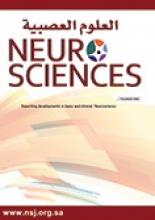Research ArticleOriginal Article
Open Access
Effects of sensory deficits on balance, functional status and trunk control in patients diagnosed with guillain–barré syndrome
Esra-Dogru Huzmeli, Nilufer-Cetisli Korkmaz, Taskin Duman and Ozden Gokcek
Neurosciences Journal October 2018, 23 (4) 301-307; DOI: https://doi.org/10.17712/nsj.2018.4.20180098
Esra-Dogru Huzmeli
From the School of Physical Therapy and Rehabilitation (Huzmeli, Gokcek), and from the Department of Neurology (Duman), Faculty of Tayfur Ata Sokmen Medicine, Hatay Mustafa Kemal University, Antakya, and from the School of Physical Therapy and Rehabilitation (Korkmaz), Pamukkale University, Denizli, Turkey
PT, PhDNilufer-Cetisli Korkmaz
From the School of Physical Therapy and Rehabilitation (Huzmeli, Gokcek), and from the Department of Neurology (Duman), Faculty of Tayfur Ata Sokmen Medicine, Hatay Mustafa Kemal University, Antakya, and from the School of Physical Therapy and Rehabilitation (Korkmaz), Pamukkale University, Denizli, Turkey
PT, PhDTaskin Duman
From the School of Physical Therapy and Rehabilitation (Huzmeli, Gokcek), and from the Department of Neurology (Duman), Faculty of Tayfur Ata Sokmen Medicine, Hatay Mustafa Kemal University, Antakya, and from the School of Physical Therapy and Rehabilitation (Korkmaz), Pamukkale University, Denizli, Turkey
MDOzden Gokcek
From the School of Physical Therapy and Rehabilitation (Huzmeli, Gokcek), and from the Department of Neurology (Duman), Faculty of Tayfur Ata Sokmen Medicine, Hatay Mustafa Kemal University, Antakya, and from the School of Physical Therapy and Rehabilitation (Korkmaz), Pamukkale University, Denizli, Turkey
PT, Msc
References
- ↵
- Alter M
- ↵
- Hughes RA,
- Cornblath DR
- ↵
- Alzaidi MA,
- Nouri KA
- ↵
- Christopher S
- ↵
- Erickson MA,
- Oliver T,
- Baldini T,
- Bach J
- ↵
- Scalha TB,
- Miyasaki E,
- Lima NM,
- Borges G
- ↵
- Patel AT,
- Duncan PW,
- Lai SM,
- Studenski S
- ↵
- Daneshjoo F,
- Taghizadeh G,
- Azad A,
- Mehdizadeh M,
- Najafabadi MM
- ↵
- Hughes RA,
- Newsom-Davis JM,
- Perkin GD,
- Pierce JM
- ↵
- Verheyden G,
- Willems AM,
- Ooms L,
- Nieuwboer A
- ↵
- Verheyden G,
- Nieuwboer A,
- Mertin J,
- Preger R,
- Kiekens C,
- De Weerdt W
- ↵
- Berg KO,
- Wood-Dauphinee SL,
- Williams JI,
- Maki B
- ↵
- Feitosa TF,
- Dantas MQS,
- Silva CB,
- Pereira A
- ↵
- Hillier S,
- Immink M,
- Thewlis D
- ↵
- Gould D
- ↵
- Fleiss JL
- ↵
- Ruts L,
- Drenthen J,
- Jongen JL,
- Hop WC,
- Visser GH,
- Jacobs BC,
- et al.
- ↵
- Aman JE,
- Elangovan N,
- Yeh IL,
- Konczak J
- ↵
- Ibrahim I,
- Abulhamid MM,
- Imam MH,
- Hussein NA,
- Awad RM
- ↵
- Kars HJ,
- Hijmans JM,
- Geertzen JH,
- Zijlstra W
- ↵
- de Jersey MC
- ↵
- Sæther R,
- Helbostad JL,
- Adde L,
- Braendvik S,
- Lydersen S,
- Vik T
- ↵
- Elshinnawy AM,
- Khalil NH
- ↵
- Di Monaco M,
- Trucco M,
- Di Monaco R,
- Tappero R,
- Cavanna A
- ↵
- Liao CF,
- Liaw LJ,
- Wang RY,
- Su FC,
- Hsu AT
In this issue
Effects of sensory deficits on balance, functional status and trunk control in patients diagnosed with guillain–barré syndrome
Esra-Dogru Huzmeli, Nilufer-Cetisli Korkmaz, Taskin Duman, Ozden Gokcek
Neurosciences Journal Oct 2018, 23 (4) 301-307; DOI: 10.17712/nsj.2018.4.20180098
Jump to section
Related Articles
- No related articles found.
Cited By...
- No citing articles found.





